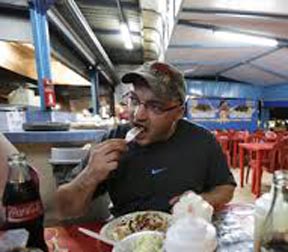
SAN DIEGO: Dan Johnson hadn’t crossed the U.S.-Mexico border in years despite the fact the San Diego native lives 20 minutes away by car and spent most of his life making weekend runs for Baja California’s surf and fish tacos.
“Everybody was scared,” Johnson said of San Diegans’ impression of their Mexican neighbor after violence spiked about eight years ago. But now Johnson, like an increasing number of Americans, is being lured back by a region that has transformed itself while fighting the drug war.
Once centered on timeshares and rowdy bars largely frequented by Americans and Canadians, northern Baja California’s tourism industry is rebounding with the exploding fame of local chefs, the expansion of boutique hotels and a burgeoning art scene creating a buzz in travel magazines.
This year, foreigners made up more than 45 percent of all visitors, after dropping to a low of less than 25 percent when cartels unleashed unprecedented bloodshed, leaving beheaded bodies on Tijuana’s streets. Sport fishing licenses – which are almost exclusively sought by Americans – have increased more than 75 percent during that time, according to Baja California’s tourism department.
Homicides in the state fell sharply, from 1,528 in 2010 to 584 in 2012, according to the latest figures from Mexico’s National Statistics and Geography Institute.
But the biggest jump in foreign tourism came after the region’s nouveau cuisine, called Baja Med, caught the attention of celebrity chefs like Anthony Bourdain and Rick Bayless, said Baja California’s former Tourism Secretary Juan Tintos, who retired on Nov. 1.
Baja Med combines the region’s seafood, cactus pads and chiles, with Mediterranean flavors, such as olive oil, vinaigrettes, and sun-dried tomatoes.
Foodies from San Francisco to Brooklyn have followed the celebrity chefs in a deepening path to Baja’s chic restaurants, like Javier Plascencia’s Mision 19 in Tijuana that offers panoramic views of the borderlands while serving tamarind Martinis topped by whipped coconut milk.
“The world of gastronomy has helped us transcend the border,” Tintos said. “It has helped people overcome their fears.”
The more sophisticated travel industry is largely the result of the industry turning to the domestic market to make up for the lost tourist dollars from foreigners.
A string of boutique hotels that mix traditional Spanish architecture with modern twists have opened in the wine-growing region of Valle de Guadalupe, a region nicknamed the Napa of Baja that is little more than an hour’s drive from the border.
Some offer wine-making, cooking and yoga classes or tours to tasting rooms where visitors can enjoy seafood caught off nearby Ensenada’s coast, homemade cheeses made at the surrounding ranches paired with local wines. The Mexico City boutique hotel developer, Grupo Habita, opened Endemico, a sleek cluster of wood-and-steel cabins perched among giant boulders with a sweeping view of the valley.
Along the coast, Ensenada has gone from Mexico’s sixth cruise ship destination in 2010 to its second this year. It is surpassed only by Cozumel, Tintos said. The number of ship passengers visiting the port is expected to double from 339,000 in 2013 to more than 700,000 next year, based on the cruises’ contracts.
Carnival Cruise Lines plans to make 200 calls a year to Ensenada starting in January when it will add a second ship to operate three- and four-day cruises from Long Beach, said Terry Thornton, senior vice president of itinerary development.
Derrik Chinn, a former San Diego newspaper reporter who moved to Tijuana in 2009, has seen business for his tour company, Turista Libre, double in the past two years.-AP






